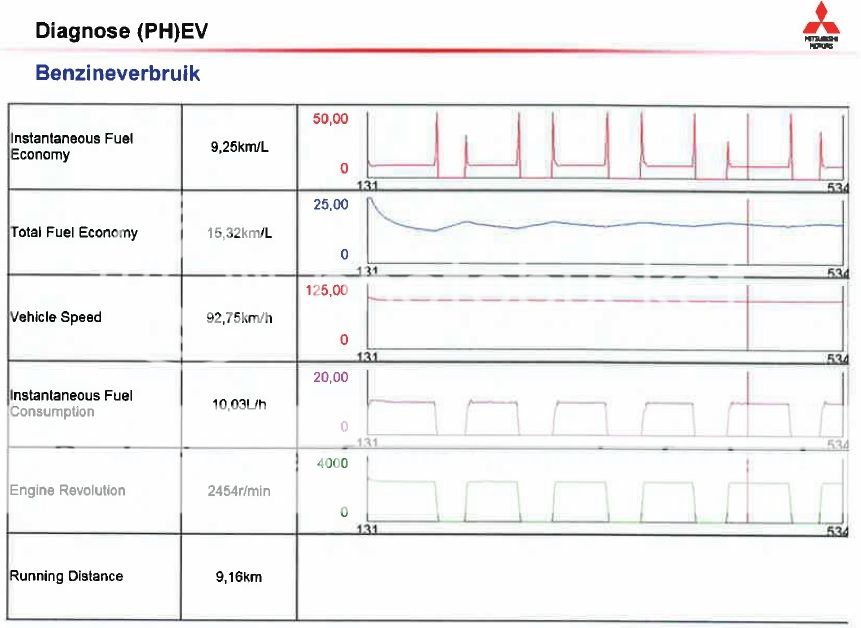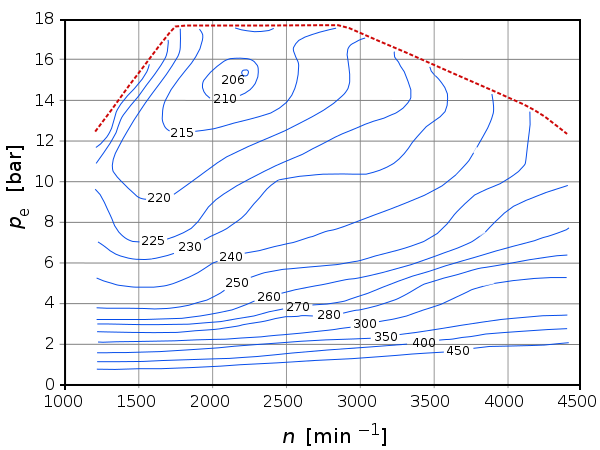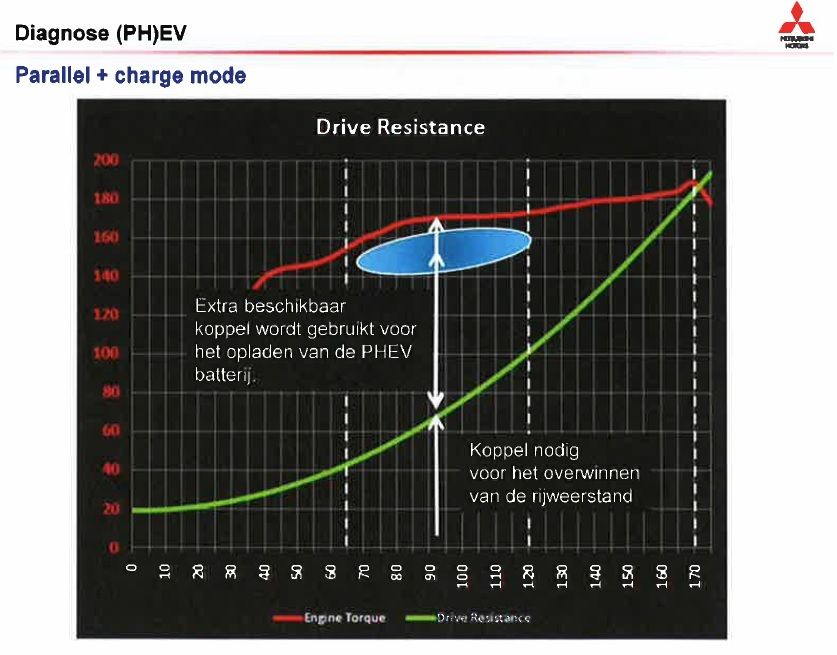Trex
Well-known member
Hi,
Just so I do not take another discussion off topic I will start a new thread. Back in the topic : "Re: Research into Wear & Tear of a hybrid (Start-Stop) engine" Page 2 this came up:
Now it is a follow on to this I want to discuss. Why does Mitsubishi use such a short gearing ratio for Parallel mode driving? I would think it fairly obvious in that we have a small 2lt petrol motor pushing along a 1.8 tonne 4WD and that is not talking about aerodynamics (bad). Then we have the requirements of any excess power to charge the hv drive battery. All in all not much chance of a longer gear ratio which as anko stated would make the petrol engine operate more efficiently. Now anko did not say we needed a overdrive just a longer gear ratio but lets see why cars have overdrive which Wikipedia state:
"Overdrive is a term used to describe the operation of an automobile cruising at sustained speed with reduced engine speed, leading to better fuel consumption, lower noise and lower wear."
Just what we want. Now for a example of overdrive. My diesel Mitsubishi Pajero which I use for towing duties has a 5th gear overdrive that when driving at around 90kph the diesel motor is spinning about 1950rpm. Now lets bring in one of my favourite graphs:

Now as can be seen in the image the PHEV's petrol motor at 92.75kph is spinning at 2454rpm. That's not good compared to the Pajero's 1950rpm. But the PHEV has a trick up its sleeve in that the petrol engine revolutions are going to zero after charging the drive battery and going into Ev mode and discharging drive battery (then restarting petrol motor and charging the drive battery etc etc). This happens as we drive along in parallel mode automatically if the loads on the PHEV are low enough ie 2454rpm 0rpm, 2454rpm 0rpm etc at 92.75kph.
Now the good thing about these graphs in the image is there is enough information to work out what the average rpm are of the petrol motor over time in this trip Mitsubishi did using a MUT-III.
The first thing to do is get all the quantities into minutes for such a short trip of 9.16Kms.
92.75kph = 1.546 km/min
10.03Lts/h = 0.167Lts/min
Now the trip of 9.16km distance divided by our 1.546km/min = 5.925 min
If the petrol motor had run all the time on this trip at 0.167Lts/min X 5.925 min = 0.989Lts consumed
But it did not run all the time and used 15.32km/Lt so 9.16km divided by 15.32km/L = 0.598Lts for 9.16km
Now the fun bit 0.598Lts used divided by 0.989Lts if motor ran all the time = 0.605 X 100 = 60.5% of the time motor actually running!
So now our badly revving petrol motor running at 2454rpm has actually been running at a average of 2454rpm X 0.605 = 1484.67rpm
1485rpm PHEV versus 1950rpm Pajero. Starting to look like a overdrive to me. Go the PHEV. :lol: I hope my math is right.
I am calling this a virtual electric overdrive.
Regards Trex.
image from anko
Just so I do not take another discussion off topic I will start a new thread. Back in the topic : "Re: Research into Wear & Tear of a hybrid (Start-Stop) engine" Page 2 this came up:
Trex said:anko said:BTW: I beieve we don't get anywhere near the sweetspot. If the engine was operating near the sweetspot (which would require a longer gear ratio),
Hi anko,
So you think we need an overdrive gear ratio?
But you also say: Otherwise, why would the car alternate between parallel and EV mode when the battery is ”empty" or Save mode is engaged?
That could be considered something just as good as overdrive ie shut the petrol motor off after charging the hv battery for a period of time could it not? An electric overdrive? Yep, I like that name.
Regards Trex.
Now it is a follow on to this I want to discuss. Why does Mitsubishi use such a short gearing ratio for Parallel mode driving? I would think it fairly obvious in that we have a small 2lt petrol motor pushing along a 1.8 tonne 4WD and that is not talking about aerodynamics (bad). Then we have the requirements of any excess power to charge the hv drive battery. All in all not much chance of a longer gear ratio which as anko stated would make the petrol engine operate more efficiently. Now anko did not say we needed a overdrive just a longer gear ratio but lets see why cars have overdrive which Wikipedia state:
"Overdrive is a term used to describe the operation of an automobile cruising at sustained speed with reduced engine speed, leading to better fuel consumption, lower noise and lower wear."
Just what we want. Now for a example of overdrive. My diesel Mitsubishi Pajero which I use for towing duties has a 5th gear overdrive that when driving at around 90kph the diesel motor is spinning about 1950rpm. Now lets bring in one of my favourite graphs:

Now as can be seen in the image the PHEV's petrol motor at 92.75kph is spinning at 2454rpm. That's not good compared to the Pajero's 1950rpm. But the PHEV has a trick up its sleeve in that the petrol engine revolutions are going to zero after charging the drive battery and going into Ev mode and discharging drive battery (then restarting petrol motor and charging the drive battery etc etc). This happens as we drive along in parallel mode automatically if the loads on the PHEV are low enough ie 2454rpm 0rpm, 2454rpm 0rpm etc at 92.75kph.
Now the good thing about these graphs in the image is there is enough information to work out what the average rpm are of the petrol motor over time in this trip Mitsubishi did using a MUT-III.
The first thing to do is get all the quantities into minutes for such a short trip of 9.16Kms.
92.75kph = 1.546 km/min
10.03Lts/h = 0.167Lts/min
Now the trip of 9.16km distance divided by our 1.546km/min = 5.925 min
If the petrol motor had run all the time on this trip at 0.167Lts/min X 5.925 min = 0.989Lts consumed
But it did not run all the time and used 15.32km/Lt so 9.16km divided by 15.32km/L = 0.598Lts for 9.16km
Now the fun bit 0.598Lts used divided by 0.989Lts if motor ran all the time = 0.605 X 100 = 60.5% of the time motor actually running!
So now our badly revving petrol motor running at 2454rpm has actually been running at a average of 2454rpm X 0.605 = 1484.67rpm
1485rpm PHEV versus 1950rpm Pajero. Starting to look like a overdrive to me. Go the PHEV. :lol: I hope my math is right.
I am calling this a virtual electric overdrive.
Regards Trex.
image from anko




































